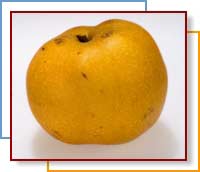Home | FOOD ARTICLES | Food Trivia | Today_in_Food_History | Food_History_Timeline | Recipes | Cooking_Tips | Food_Videos | Food_Quotes | Who’s_Who | Culinary_Schools_&_Tours | Food_Trivia_Quizzes | Food_Poems | Free_Magazines | Food_Festivals_and_Events
Food Articles, News & Features Section
FREE Magazines
and other Publications
Free Professional and Technical Research, White Papers, Case Studies, Magazines, and eBooks
See also: Pears
ASIAN PEAR - Chinese Pear, Japanese Pear, Sand, Nashi, Apple Pear
Asian pears are cousins to the pears that are typically seen in grocery stores, but this fruit is similar to an apple and its many names reflect that characteristic. Other names that this fruit goes by are: Chinese pear, Japanese pear, Sand, Nashi, and apple pear.
Asian pears differ from the traditional European ones. These pears are usually round, firm to touch when ripe, and are ready to eat after harvest. Asian pears reach prime quality when they ripen on the tree, like an apple and peach. These pears will be crisp, juicy, and slightly sweet with some tartness, especially near the core.
While European pears have the bulbous bottoms and tapering tops, they are not ready to eat until they are slightly soft and must be picked during the green stage and ripen at room temperature. European pears will be soft and juicy, with a sweeter, mellower taste. European pears will be brown at the core and an unpleasant taste if they are tree-ripened. 
There are several Asian pear varieties available. Japanese pears are more round in shape, while the Chinese pears are more oval or pyriform (pear-shaped).
In the United States, the Japanese type of Asian pear called 20th Century or Nijisseki is the most popular. It is easily identified with its round shape and smooth yellow skin. Other common varieties include the Japanese bronze-toned Hosui pear and the pear-shaped Ya Li, a pale-green Chinese variety
Selection
Select the most fragrant and unbruised fruit with little to no brown spots. Ripe Asian pears are hard and do not soften. They are ready to eat when purchased.
Storage
Asian pears are known for keeping well. Store pears a week at room temperature or up to three months in the refrigerator.
Make Asian Pears Part of Your 5 A Day Plan
-Enjoy eating fresh out of hand.
-Use in salads, slaws, soups, and sandwiches.
-Use Asian pears as you would with other pears and apples in cobblers and fruit crisps.
-To prevent discoloration when cut, dip in a mixture of water and lemon juice.
NUTRITION
Serving size 122g
Amounts Per Serving - % Daily Value*
Calories 50
Calories from Fat 5
Total Fat 0g - 0%
Saturated Fat 0g - 0%
Cholesterol 0mg - 0%
Sodium 0mg - 0%
Total Carbohydrate 13g - 4%
Dietary Fiber 4g - 16%
Sugars 9g
Protein 1g
Vitamin A 0%
Vitamin C 8%
Calcium 0%
Iron 2%
* Percent Daily Values are based on a 2,000 calorie diet.
RELATED ARTICLES
Please feel free to link to any pages of FoodReference.com from your website.
For permission to use any of this content please E-mail: james@foodreference.com
All contents are copyright © 1990 - 2025 James T. Ehler and www.FoodReference.com unless otherwise noted. All rights reserved.
You may copy and use portions of this website for non-commercial, personal use only.
Any other use of these materials without prior written authorization is not very nice and violates the copyright.
Please take the time to request permission.

